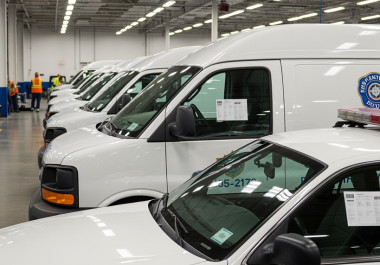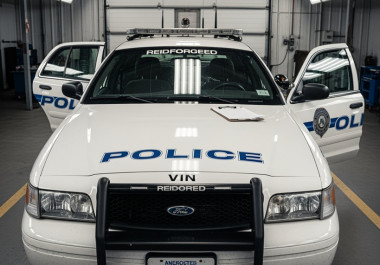Walk through a salvage yard and the first thing that hits you isn't the sight, but the smell. It's a sharp mix of burnt plastic, damp upholstery, and cold, hard reality. These are the cars that have been through fire and flood, the ones that have seen much better days. Their rock-bottom prices on platforms like RAW2K are tempting, a quiet promise of what could be. But every dent and scorch mark tells a story of risk. The trick is knowing whether you're buying a bargain or just someone else's expensive problem.
How a Car Ends Up on the Block
When a car gets tangled up in a serious fire or sits for days in floodwater, the owner’s insurance company usually throws in the towel. They’ll declare it a total loss because the cost of putting it right is just too high. From there, the written-off vehicle is moved on, finding its way into the general flow of online vehicle auctions.
-
Fire-damaged cars carry the scars of everything from a small electrical flare-up to a full-on blaze that leaves behind a stubborn, smoky smell and wiring that’s as brittle as old plastic.
-
Flood-damaged cars are often victims of a storm or a burst riverbank. The damage they suffer is silent and creeping, with corrosion and ruined electronics being the biggest enemies.
The insurer just wants to cut its losses. And that’s how these wounded machines end up under the auctioneer's gaze, sold as seen, with all their flaws and secrets.
The Dream of Finding Treasure
So why on earth would anyone take on such a massive risk? Simple. The potential payoff is huge.
The Ultimate Knock-Down Price
The biggest temptation is the price. A fire or flood-damaged car can sell for a sliver of its true market value. If you know your way around a toolbox or have a mechanic you trust, that initial saving can be the start of something special. You could bag a luxury SUV for the price of a city runaround and spend the weekends carefully nursing it back to health.
A Goldmine for Spare Parts
Sometimes, it’s not about saving the whole car. A written-off vehicle can be a treasure chest of parts. That one bit of interior trim you can't find anywhere, a solid engine block, or an undamaged door can be pulled from a wreck, saving you a fortune. For anyone restoring a classic, these donor cars are priceless. This approach works for all sorts of projects, whether you're fixing up a car or need parts from the van auctions for a commercial vehicle.
The Unseen Battle Ahead
That low price tag is tempting, but it’s just the entry fee. With salvage, the real cost is hidden in the problems you can't see, the issues that will test both your nerve and your wallet.
Flood-damaged cars are a tricky beast. Rust is the big worry, and it's a quiet killer. It can be eating away at the car’s bones, the chassis and subframe, long before you spot a single bubble of it on the paint. By the time you do, the real strength of the car could be gone, rotten from the inside out. If it's been in saltwater, that process is ten times faster. With fire-damaged cars, the intense heat creates a different kind of chaos, melting vital plastics and turning the wiring loom into a brittle, confusing mess that can take weeks to untangle.
And the costs add up. The persistent, musty smell of a flood car often means the entire interior needs to be binned. The stubborn, acrid scent of smoke can cling to every surface, a ghost that refuses to leave. These aren't simple cleaning jobs; they are expensive, professional treatments.
But for every cautionary tale, there are stories that keep the dream alive. Think of the flood-damaged estate car that everyone wrote off. Its electrics were dead and the cabin was a muddy mess. A lost cause. But one bidder looked closer and saw that the engine was untouched. It took weeks of painstaking work, tracing wires and replacing carpets, but that car lived again. It became a faithful daily runner, a testament to a gamble that paid off.
Playing Detective Before You Bid
You have to look at these cars with different eyes. Every stain, smell, and warped panel tells a part of the story. Before you even consider bidding, it pays to understand the auction rules, as the terms and conditions can vary.
Reading the Scars of a Fire
A small fire under the bonnet is a world away from a cabin that's been engulfed. You need to know which one you’re dealing with. Look for bubbled paint on the bonnet or a warped dashboard; these are clues of extreme heat that can weaken the car’s structure. And trust your nose. If the smoky smell is overwhelming, be prepared for a long and costly battle to get rid of it.
Uncovering the Secrets of a Flood
With a flood car, the watermark is your guide. How high did the water get? If it stayed below the doorsills, you might be lucky. If it reached the dashboard, you are looking at a full-scale electrical transplant. Lift every carpet and check the spare wheel well for dampness. That moisture can linger for weeks, quietly cultivating rust and mould.
The Bidder's Mindset: Nerves of Steel
It is vital to walk into a salvage auction with a clear head. Decide on your absolute maximum budget, factoring in transport and the worst-case scenario for repairs, and stick to it. No exceptions. Know exactly what you want the car for. A parts donor has different standards than a car you plan to put back on the road.
After the Gavel Falls: The Real Work Begins
Winning the bid is just the start. You'll need to sort the payment and paperwork quickly. If you run into any trouble or just need a bit of guidance on what to do next, getting in touch with the team is always a good idea. Remember, you can’t just drive your new project home. It will need to be legally transported on a recovery truck.
The Final Verdict: A Labour of Love or a Costly Mistake?
Let’s be honest. Taking on one of these cars is a huge gamble. It could become a money pit that will test your patience and drain your bank account. But for the right person, for someone with the skill, the time, and a bit of luck, it can be an amazing experience. There’s a special kind of pride that comes from rescuing a car from the brink and giving it a second life.
If you have the spirit for a real automotive adventure, the first step is to register an account to start bidding. You can browse all the car auctions from your own home and do your homework. For more guides and tips, our News section has plenty of articles to help you learn the ropes.




